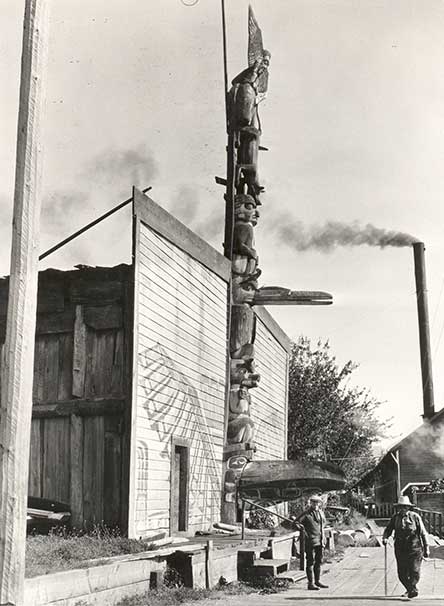
High‐ranking Kwakwaka’wakw woman on platform meant to represent slaves, c. 1914.
The blanket and skirt worn by this woman is made from shredded cedar bark. The wall behind the woman is one large diagonally-woven cedar bark mat.
Photo: Edward S. Curtis USN‐3987

Bark Breaker, c. 1914.
Kwakwaka’wakw woman wearing a cedar bark blanket made of shredded cedar bark. She is softening cedar bark that was dried out after pulling it from the tree in the spring. The cedar bark is held over the edge of an old paddle and she has a tool called a bark beater that she hits the cedar bark with. This process softens the bark so that clothing and regalia can be made from it. Another tool used to make the cedar bark soft was a cedar bark shredder. This tool was either made of yew wood or a whale bone.
Photo: Edward S. Curtis

Wakas pole in front of family’s Bighouse, Alert Bay, early 20th Century
K´wamx’udi, Chief Charlie Walkus, also called Numas, was the owner of this Bighouse. Guests would enter through the beak of the Raven, which was made from a canoe. The right to display the Wakas house‐front and pole comes from the neighbouring Wuikinuxv First Nation, River’s Inlet.
Both the Wakas totem pole and the Bighouse are made of cedar wood.
Photo: National Archives of Canada, PN 47754

Kwaxalanukwame', Odan, Chief Johnny Drabble wearing Baxwbakwalanuksiwe' mask and costume after surrender of regalia, Parish Hall, Alert Bay, 1922
The outer edge of the mask is framed by short strands of shredded cedar bark. A long cedar bark cape made of shredded bark is also worn by Chief Drabble. He is also holding a rattle that has shredded cedar bark attached to the sides.
Photo: William Halliday, Royal BC Museum, AA 188

Kwaxalanukwame’ ‘Namugwis, Chief William T. Cranmer, son of Pal’nakwala Wakas, Chief Dan Cranmer who hosted 1921 potlatch that led to the forced surrender of 100's of pieces of potlatch regalia and arrest of 45 people (of the 45 people charged, 22 received suspended sentences, 3 were remanded for appeal and 20 were sent to Oakalla Prison near Vancouver).
Chief Cranmer is wearing a cedar bark neck ring and cedar bark headpiece that has large abalone shell pieces and white ermine skins attached to it.